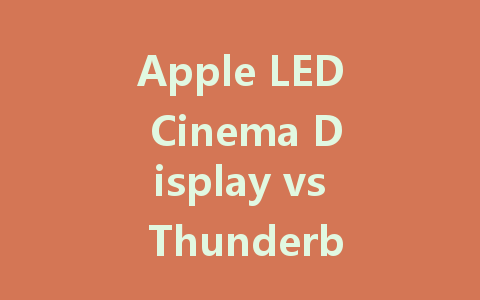
When it comes to Apple’s display technology, two models stand out: the LED Cinema Display and the Thunderbolt Display. Both of these monitors provide excellent visual experiences and have been incredibly popular among creative professionals, gamers, and casual users alike. However, deciding which one is better for your needs can be a bit confusing. In this article, we’ll dive into the specifications, features, and capabilities of each display to help you make an informed choice.
Overview of Both Displays
Apple LED Cinema Display
Released in 2010, the Apple LED Cinema Display was designed with the creative community in mind. It features a 27-inch screen with a sleek aluminum and glass design that complements Apple’s aesthetic perfectly. The LED backlighting provides vibrant colors and deep blacks, making it particularly appealing for photo and video editing.
Apple Thunderbolt Display
Introduced in 2011, the Thunderbolt Display builds upon the foundation set by the Cinema Display. While it maintains the stunning 27-inch display and overall design, the Thunderbolt version offers upgraded performance and connectivity options. With the introduction of Thunderbolt technology, this display significantly enhances speed and functionality, making it a powerhouse for users who require rapid data transfer and functionality.
Display Quality: Color Accuracy and Resolution
Resolution
Both displays boast a high-resolution screen of 2560 x 1440 pixels, which offers crisp detail and excellent clarity. This resolution is particularly effective for tasks that demand precision, such as graphic design or video editing.
Color Accuracy
When it comes to color accuracy, both displays offer excellent performance, but the Thunderbolt Display is generally considered to have a slight edge. It uses advanced color calibration standards, making it ideal for professionals whose work relies heavily on true-to-life color representation.
Connectivity Options
Apple LED Cinema Display
The LED Cinema Display comes with standard Apple connectors such as the MagSafe power connector, USB, and Mini DisplayPort. While these options are functional, they may feel somewhat limited in comparison to newer technologies.
Apple Thunderbolt Display
The Thunderbolt Display, on the other hand, features a Thunderbolt port that allows for daisy chaining multiple devices, making it extremely versatile. In addition to Thunderbolt, it includes three USB 2.0 ports, a FireWire 800 port, and a Gigabit Ethernet port. This expanded connectivity makes it simpler to manage various peripherals without sacrificing performance.
Audio and Camera Features
Built-in Audio
Both displays have built-in speakers that deliver decent sound quality for casual use. However, for audio professionals or users who prioritize sound quality, investing in external speakers or an audio system is recommended.
Integrated Camera
Another advantage of the Thunderbolt Display lies in its integrated FaceTime HD camera. This feature is particularly useful for users who frequently engage in video calls or conferences, offering better resolution compared to the older Cinema Display model.
Performance: Speed and Efficiency
Refresh Rate
Both monitors offer a smooth refresh rate that creates fluid motion for games and videos alike. Users can expect excellent performance regardless of the display they choose.
Energy Efficiency
Apple’s designs prioritize energy efficiency, but the Thunderbolt Display may have a slight advantage due to advancements in technology and power consumption efficiency. Apple continues to emphasize environmentally friendly production methods, leading to both displays being considerate options for eco-conscious consumers.
Price and Availability
When it comes to pricing, the Thunderbolt Display often commands a higher price due to its advanced features and enhanced capabilities. However, both monitors can often be found on the second-hand market, making them accessible for different budgets.
Which Display Should You Choose?
Choosing between the Apple LED Cinema Display and the Thunderbolt Display ultimately depends on your individual needs and budget.
Conclusion
In the end, both the Apple LED Cinema Display and the Thunderbolt Display offer exceptional visual experiences. Each model has its strengths and weaknesses, but understanding those aspects will help you make an informed decision. Whether you’re a creative professional or someone who enjoys high-quality visuals for casual use, there’s an Apple display fit for your needs. So consider the specifications outlined in this article, factor in your specific use case, and you’ll be well on your way to choosing the perfect monitor!